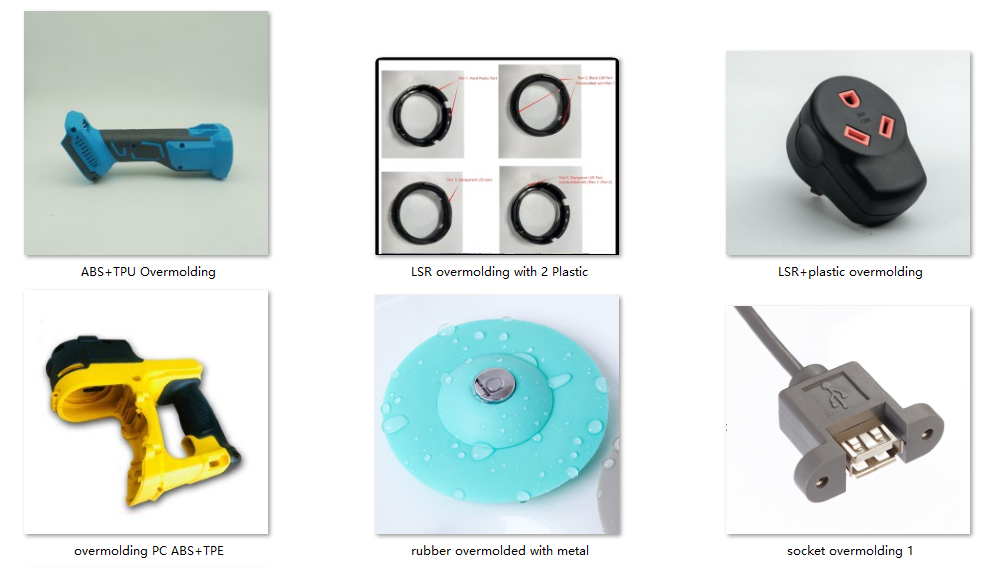Overmolding is a transformative manufacturing technique that opens a world of possibilities for product design, functionality, and user experience. But the critical question often isn’t whether to overmold, but which material to use for the overmold. The debate frequently centers on two powerful contenders: Liquid Silicone Rubber (LSR) and engineering plastics.
Choosing between them isn’t about finding a superior material, but the right material for your application. This article breaks down the key differences to guide your decision.
The Core Distinction: Material Nature and Process
The most fundamental difference lies in the materials’ inherent properties and how they are processed:
- Plastic over Plastic Overmolding: This involves molding one thermoplastic (e.g., PC, ABS, Nylon) over another. The bond is primarily mechanical and chemical. The substrate is designed with undercuts and holes, and the molten plastic chemically fuses to it during the second shot. This process requires precise control of melt temperatures.
- LSR over Plastic Overmolding: This involves molding Liquid Silicone Rubber over a thermoplastic substrate (often PBT, PC, or Nylon). LSR is a thermoset material that cures via a platinum-catalyzed reaction. The bond is almost exclusively mechanical. The substrate must be designed with robust undercuts and gates, as LSR will not chemically adhere to the plastic. This process requires a cold runner system and separate, heated curing molds.
Head-to-Head Comparison: Where Each Excels
| Feature | Liquid Silicone Rubber (LSR) Overmolding | Plastic Over Plastic Overmolding |
|---|---|---|
| Primary Bonding Method | Mechanical interlock (undercuts, through-holes). | Mechanical & Chemical fusion. |
| Tactile & Ergonomics | Exceptional. Inherently soft, compliant, and provides a non-slip, comfortable grip. | Limited. Can be rigid; soft-touch effects require specific TPEs/TPUs. |
| Performance & Durability | Excellent. High temp resistance (up to 250°C+), UV stability, biocompatibility, and superior sealing capabilities. | Good. Varies greatly by plastic type. Generally lower heat and chemical resistance than LSR. |
| Aesthetics & Finish | High-clarity, seamless options. Can feel “medical” or “premium.” Color consistency is high. | Wide range of finishes (glossy, matte). Allows for complex multi-color and multi-material designs. |
| Typical Applications | Seals & gaskets, medical device grips, baby products, soft-touch buttons, automotive seals. | Tool handles, multi-colored housings, structural components, protective bumpers. |
Making the Choice: A Simple Guide for Your Project
Choose LSR Overmolding when your application demands:
- Superior Sealing: For creating water-proof, air-tight, or dust-proof seals directly integrated into the part.
- Extreme Environment Performance: When the product must withstand high temperatures, UV radiation, or harsh chemicals.
- Biocompatibility & Safety: For medical, healthcare, or food-contact applications where non-toxicity and sterilizability are paramount.
- Premium Soft-Touch Feel: For ergonomic grips that need to be durable, non-slip, and comfortable (e.g., power tools, high-end electronics).
Choose Plastic Overmolding when your primary goals are:
- Structural Integrity & Rigidity: To create a strong, monolithic multi-plastic component.
- Complex Aesthetics: For creating striking visual designs with multiple colors or distinct material sections in a single part.
- Cost-Effectiveness for Simpler Needs: When a basic overmold is needed for impact protection or a slight grip enhancement, and LSR’s high-performance properties are overkill.
- Chemical Bonding: When you can leverage material compatibility (e.g., using the same polymer family) to create an exceptionally strong bond without complex mechanical designs.
Conclusion: Function Drives the Decision
The choice between LSR and plastic overmolding ultimately boils down to the required function of the overmolded layer.
- If you need to add a sealing, insulating, or soft, durable grip that performs in tough conditions, LSR is the undisputed champion.
- If you are aiming for enhanced aesthetics, structural reinforcement, or a simpler textured grip, plastic overmolding offers a versatile and effective solution.
Understanding these core distinctions at the early design stage is crucial. It influences everything from material selection and tooling design to the final cost and performance of your product. By aligning your project’s requirements with the inherent strengths of each process, you can unlock the full potential of multi-material design.For more information ,please contact Rilong team .



